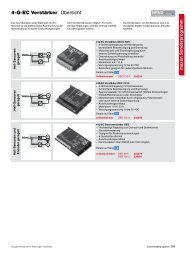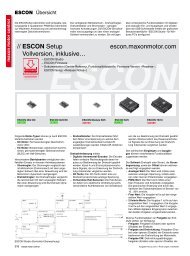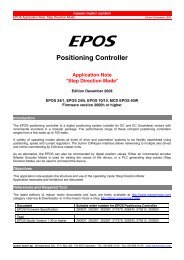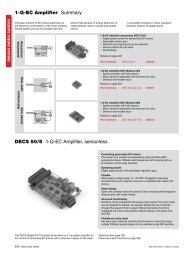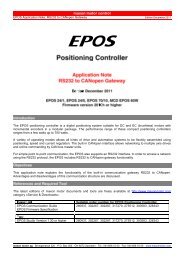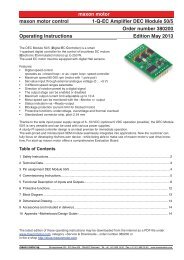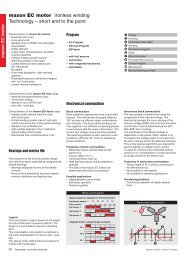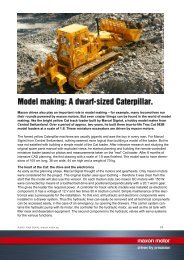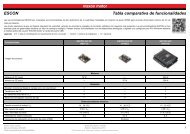EPOS Application Note: CANopen Basic Information - Maxon Motor ag
EPOS Application Note: CANopen Basic Information - Maxon Motor ag
EPOS Application Note: CANopen Basic Information - Maxon Motor ag
You also want an ePaper? Increase the reach of your titles
YUMPU automatically turns print PDFs into web optimized ePapers that Google loves.
maxon motor control<br />
<strong>EPOS</strong> <strong>Application</strong> <strong>Note</strong>: <strong>CANopen</strong> <strong>Basic</strong> <strong>Information</strong><br />
<strong>EPOS</strong> Positioning Controller<br />
PDO Transmissions<br />
PDO transmissions may be driven by remote requests, event triggered and by the Sync mess<strong>ag</strong>e received:<br />
- Remotely requested:<br />
Another device may initiate the transmission of an asynchronous PDO by sending a remote transmission<br />
request (remote frame).<br />
- Event Triggered (only Transmit PDOs):<br />
An event of a mapped Object (e.g. velocity changed) will cause the transmission of this TxPDO. Sub-Index<br />
3h of the object ‘Transmit PDO X Parameter’ contains the inhibit time. This time is a minimum interval for<br />
PDO transmission. The value is defined as multiple of 100 us.<br />
- Synchronous transmission:<br />
In order to initiate simultaneous sampling of input values of all nodes, a periodically transmitted Sync<br />
mess<strong>ag</strong>e is required. Synchronous transmission of PDOs takes place in cyclic and acyclic transmission<br />
mode. Cyclic transmission means that the node waits for the Sync mess<strong>ag</strong>e, after which it sends its<br />
measured values. Its PDO transmission type number (1 to 240) indicates the Sync rate it listens to (how<br />
many Sync mess<strong>ag</strong>es the node waits before the next transmission of its values). The <strong>EPOS</strong> supports only<br />
Sync rates of 1.<br />
PDO Mapping<br />
The default mapping of application objects<br />
as well as the supported transmission<br />
mode is described in the Object Dictionary<br />
for each PDO. PDO identifiers should<br />
have high priority to guarantee a short<br />
response time. PDO transmission is not<br />
confirmed. The PDO mapping defines<br />
which application objects are transmitted<br />
within a PDO. It describes the sequence<br />
and length of the mapped application<br />
objects. A device that supports variable<br />
mapping of PDOs must support this<br />
during the pre-operational state. If<br />
dynamic mapping during operational state<br />
is supported, the SDO Client is<br />
responsible for data consistency.<br />
Figure 18: PDO mapping<br />
Edition May 2008 / Subject to change maxon motor control 11



